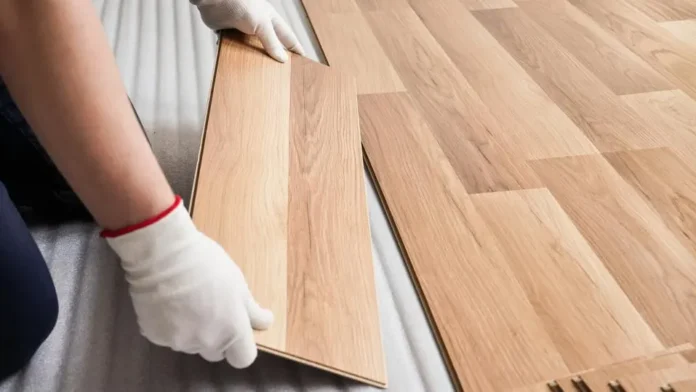When it comes to flooring options, the choice between hardwood and laminate can be a tough one. Both offer their own unique advantages and drawbacks, making it essential for homeowners to carefully consider their needs before making a decision. Wood flooring has a timeless appeal that adds warmth and sophistication to any space. Whether you prefer the rustic charm of reclaimed wood or the sleek elegance of engineered hardwood, there are endless options to suit your style and budget. Hardwood flooring exudes elegance and timeless beauty, while laminate offers durability and affordability. To help you navigate this flooring conundrum, we have compiled a comprehensive guide that will delve into the pros and cons of hardwood and laminate flooring, ultimately helping you determine which option is best suited for your home.
What Is Hardwood Flooring?
Hardwood flooring is a timeless and elegant choice for any home. It is made from natural wood, usually sourced from deciduous trees such as oak, maple, or cherry. The unique patterns of the wood grains create a rich and warm look that adds character to any space. Hardwood floors are also known for their durability and longevity when properly maintained.
What Is Laminate Flooring?
Laminate flooring is a popular choice for homeowners who want the look of hardwood at a more affordable price. Made from layers of synthetic materials that are fused together, laminate flooring is designed to mimic the appearance of real wood. With advanced printing technology, laminate floors can replicate the natural grains and textures of various wood species, providing a wide range of options to suit any style or preference.
Pros Of Hardwood Flooring:
1. Timeless Beauty:
One of the greatest advantages of hardwood flooring is its timeless beauty. With its natural grains and rich colors, hardwood instantly adds a sense of warmth and elegance to any room. Unlike laminate flooring, which can look synthetic or mimic the appearance of wood but never quite match up, hardwood offers a genuine and authentic look that never goes out of style.
2. Durability:
Hardwood floors are known for their durability and longevity. When properly cared for, they can last for generations, making them an excellent investment for homeowners. In high-traffic areas, such as living rooms or hallways, hardwood is more resistant to scratches and dents compared to laminate flooring. Additionally, if damage does occur over time, it is often possible to sand and refinish hardwood floors to restore their original appeal.
Cons Of Hardwood Flooring:
1. Cost:
One major drawback of hardwood flooring is its cost. Compared to laminate flooring, installing hardwood can be significantly more expensive due to materials costs and professional installation fees. Furthermore, if you choose exotic or rare species of wood for your floorboards (such as mahogany or Brazilian cherry), the cost will naturally increase even further.
2. Vulnerability To Moisture:
While some types of hardwood are more moisture-resistant than others (such as engineered wood), all forms of solid wood are inherently sensitive to changes in temperature and humidity levels.
Pros And Cons Of Laminate Flooring
Laminate flooring has become increasingly popular in recent years due to its affordability and durability.
- One of the main advantages of laminate flooring is its ability to mimic the look of hardwood at a fraction of the cost. With advanced printing technology, laminate flooring can now replicate the texture, grain, and even the knots found in real hardwood. This makes it a great option for homeowners who want the aesthetic appeal of wood without breaking their budget.
- Another advantage of laminate flooring is its ease of installation. Unlike traditional hardwood flooring that requires professional installation, laminate floors often come with a click-lock system that allows for a simple DIY installation. This means that homeowners can save on labor costs and have their new floors up and ready in no time.
On the other hand, one drawback of laminate flooring is its susceptibility to moisture damage. While manufacturers have made improvements over the years by creating water-resistant laminates, they are still not completely waterproof like some types of hardwood or luxury vinyl planks. Therefore, if you live in an area prone to flooding or have young children who are prone to spills, you may need to take extra precautions when choosing laminate as your flooring option. Hardwood floor refinishing in San Diego offers homeowners a chance to renew the natural beauty and elegance of their flooring. Whether you have just bought a new home or want to give your existing space a fresh look, refinishing your hardwood floors is an excellent option.
Additionally, although there has been significant progress in replicating the look and feel of real wood with laminate materials, it still can’t beat the authentic beauty and warmth provided by genuine hardwood floors. Hardwood offers unique variations in color and pattern that simply cannot be matched by any synthetic product.
Conclusion:
In conclusion, choosing between hardwood and laminate flooring ultimately comes down to your specific needs and budget. Hardwood flooring offers a timeless beauty and natural warmth that can enhance the value of your home. It is also more durable and longer-lasting compared to laminate options, making it a worthwhile investment in the long run.
On the other hand, laminate flooring provides an affordable alternative that mimics the look of hardwood without breaking the bank. It is highly resistant to scratches, moisture, and stains, making it ideal for households with pets or young children. Additionally, laminate is relatively easy to install and requires minimal maintenance.
Ultimately, when deciding between hardwood and laminate flooring for your home, it’s vital to consider factors such as personal preferences in terms of aesthetics and functionality, as well as the specific requirements of your household’s lifestyle. By carefully weighing these factors against your budget constraints, you can make an informed decision that will both suit your style preferences and provide lasting satisfaction in your home.
